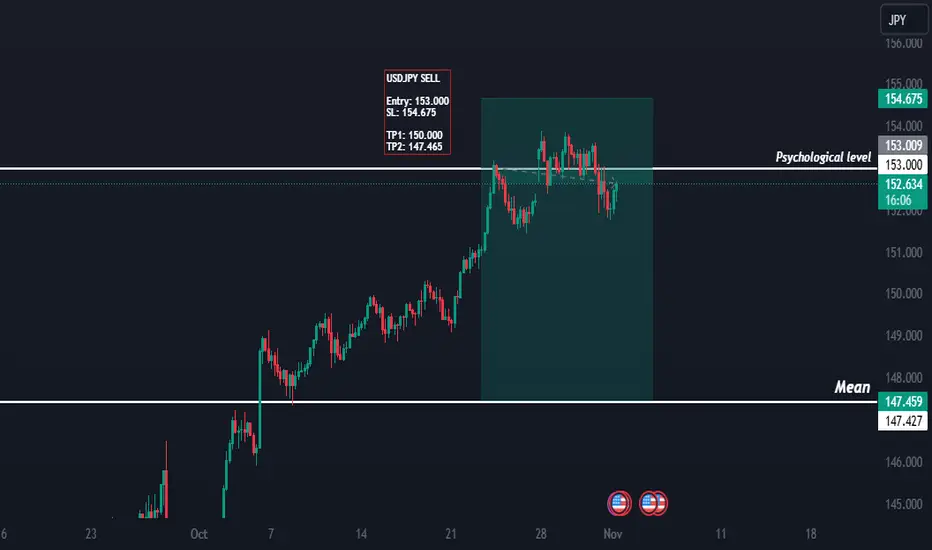Introduction
Today’s analysis of the USDJPY pair suggests a potential for slight bearish movement. Key fundamental factors, including recent US and Japanese economic data and central bank positions, seem to favor a downside bias. Let’s examine these drivers in detail to provide a comprehensive view for traders and investors monitoring the USDJPY.
1. Federal Reserve’s Dovish Tone
The US Federal Reserve’s latest communication indicates a cautious approach, with market participants widely expecting the Fed to maintain its current interest rate. This dovish tone, coupled with moderating US economic data, could weaken the US Dollar. If the Fed holds rates or hints at potential rate cuts in 2024, this could weigh on the USD, providing room for JPY strength against the Dollar. Consequently, the market’s perception of a less aggressive Fed policy may contribute to the USDJPY pair’s bearish bias today.
2. Bank of Japan’s Evolving Stance
The Bank of Japan (BoJ) has recently shown signs of potentially moving away from its ultra-loose policy stance. Governor Kazuo Ueda’s comments have signaled a potential shift in monetary policy, raising speculation around adjustments in yield control measures. Any further tightening of Japanese yields or gradual normalization signals may strengthen the JPY as Japanese bond yields rise, attracting capital inflows. This shift, however gradual, could support a stronger JPY, thereby pressuring USDJPY downward.
3. Japanese Economic Resilience
Japan’s economy has recently demonstrated steady resilience, with improved inflation data aligning closer to the BoJ’s targets. Stronger-than-expected inflation readings and positive manufacturing activity lend support to the JPY. The BoJ’s confidence in these indicators may reinforce market sentiment that Japan is on a steady path to growth. Consequently, with USD expected to remain relatively soft, this positions the JPY more favorably in the USDJPY pair, reinforcing today’s bearish outlook.
4. Risk Sentiment and Safe-Haven Flows
In today’s mixed risk sentiment environment, safe-haven assets like the JPY often become more attractive. Investors may favor the JPY in times of global economic uncertainty or as geopolitical events unfold. As the US Dollar is pressured by softer economic indicators, the JPY’s safe-haven appeal may drive demand, contributing to USDJPY’s bearish tendency today.
Conclusion
In conclusion, the USDJPY pair shows potential for a slight bearish bias today due to the Fed’s cautious stance, the BoJ’s gradual policy evolution, resilient Japanese economic data, and safe-haven flows favoring the JPY. Traders may find it beneficial to watch these fundamental factors closely, as they provide critical insights into USDJPY’s likely direction.
Keywords:
#USDJPYanalysis,
#USDollar,
#JapaneseYen,
#USDJPYbearishbias,
#ForextradingNovember12024,
#FederalReservepolicy,
#Bankof Japanstance,
#JPYstrength,
#Safehavencurrency,
#Forextechnicalanalysis,
#Japaneseinflationdata,
#Forextradinginsights.
Today’s analysis of the USDJPY pair suggests a potential for slight bearish movement. Key fundamental factors, including recent US and Japanese economic data and central bank positions, seem to favor a downside bias. Let’s examine these drivers in detail to provide a comprehensive view for traders and investors monitoring the USDJPY.
1. Federal Reserve’s Dovish Tone
The US Federal Reserve’s latest communication indicates a cautious approach, with market participants widely expecting the Fed to maintain its current interest rate. This dovish tone, coupled with moderating US economic data, could weaken the US Dollar. If the Fed holds rates or hints at potential rate cuts in 2024, this could weigh on the USD, providing room for JPY strength against the Dollar. Consequently, the market’s perception of a less aggressive Fed policy may contribute to the USDJPY pair’s bearish bias today.
2. Bank of Japan’s Evolving Stance
The Bank of Japan (BoJ) has recently shown signs of potentially moving away from its ultra-loose policy stance. Governor Kazuo Ueda’s comments have signaled a potential shift in monetary policy, raising speculation around adjustments in yield control measures. Any further tightening of Japanese yields or gradual normalization signals may strengthen the JPY as Japanese bond yields rise, attracting capital inflows. This shift, however gradual, could support a stronger JPY, thereby pressuring USDJPY downward.
3. Japanese Economic Resilience
Japan’s economy has recently demonstrated steady resilience, with improved inflation data aligning closer to the BoJ’s targets. Stronger-than-expected inflation readings and positive manufacturing activity lend support to the JPY. The BoJ’s confidence in these indicators may reinforce market sentiment that Japan is on a steady path to growth. Consequently, with USD expected to remain relatively soft, this positions the JPY more favorably in the USDJPY pair, reinforcing today’s bearish outlook.
4. Risk Sentiment and Safe-Haven Flows
In today’s mixed risk sentiment environment, safe-haven assets like the JPY often become more attractive. Investors may favor the JPY in times of global economic uncertainty or as geopolitical events unfold. As the US Dollar is pressured by softer economic indicators, the JPY’s safe-haven appeal may drive demand, contributing to USDJPY’s bearish tendency today.
Conclusion
In conclusion, the USDJPY pair shows potential for a slight bearish bias today due to the Fed’s cautious stance, the BoJ’s gradual policy evolution, resilient Japanese economic data, and safe-haven flows favoring the JPY. Traders may find it beneficial to watch these fundamental factors closely, as they provide critical insights into USDJPY’s likely direction.
Keywords:
#USDJPYanalysis,
#USDollar,
#JapaneseYen,
#USDJPYbearishbias,
#ForextradingNovember12024,
#FederalReservepolicy,
#Bankof Japanstance,
#JPYstrength,
#Safehavencurrency,
#Forextechnicalanalysis,
#Japaneseinflationdata,
#Forextradinginsights.
Disclaimer
The information and publications are not meant to be, and do not constitute, financial, investment, trading, or other types of advice or recommendations supplied or endorsed by TradingView. Read more in the Terms of Use.
Disclaimer
The information and publications are not meant to be, and do not constitute, financial, investment, trading, or other types of advice or recommendations supplied or endorsed by TradingView. Read more in the Terms of Use.
